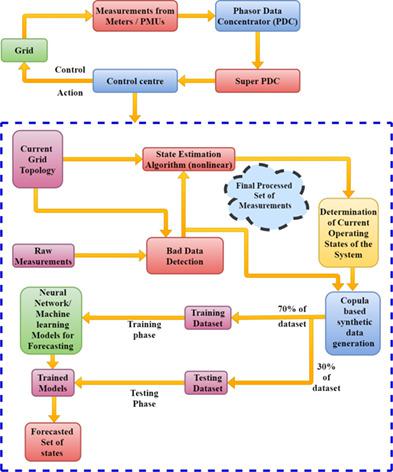当前位置:
X-MOL 学术
›
Int. Trans. Electr. Energy Syst.
›
论文详情
Our official English website, www.x-mol.net, welcomes your
feedback! (Note: you will need to create a separate account there.)
Application of deep learning for power system state forecasting
International Transactions on Electrical Energy Systems ( IF 1.9 ) Pub Date : 2021-05-01 , DOI: 10.1002/2050-7038.12901 Debottam Mukherjee 1 , Samrat Chakraborty 2 , Sandip Ghosh 1 , Rakesh Kumar Mishra 1
International Transactions on Electrical Energy Systems ( IF 1.9 ) Pub Date : 2021-05-01 , DOI: 10.1002/2050-7038.12901 Debottam Mukherjee 1 , Samrat Chakraborty 2 , Sandip Ghosh 1 , Rakesh Kumar Mishra 1
Affiliation

|
The recent trend in modern power sector is to maintain observability of the grid for its smooth operation under all circumstances. To ascertain this aforementioned criterion, grid operators employ state estimation algorithms with a priori measurement data to determine the current operating states of the grid. The prime ideology behind such algorithms is the presence of an over-determined class of system with abundant measurement redundancy. With loss of real time measurement data, operators resort to state forecasting-based solutions. This work focuses on the use of scalable deep learning and machine learning models for appropriate forecasting of operating states both for healthy and contingency scenarios. This work also incorporates a critical comparison between them based on RMSE, MSE, MAE and R-squared index. To facilitate a better training and to prevent model underfitting, Gaussian copula based synthetic data are incorporated showcasing substantial enhancement in performance indices of the models [GRU (0.7958 → 0.0088), LSTM (1.1173 → 0.1020), SVM (1.7256 → 0.1654) and SNN (2.5381 → 0.1972)]. Such training strategies even under system unobservability with optimal hyper-parameter tuning of the models can lead to proper forecasting of operating states of the system. A comparative analysis between the neural network models under varying noise scenarios also portrays the efficacy of the proposed GRU model. The proposed architecture can also be implemented for real time state forecasting scheme with computational time in the order of micro (μ) seconds (210.34 μs). Simulation results on IEEE 14 bus system validate these aforementioned propositions.
中文翻译:

深度学习在电力系统状态预测中的应用
现代电力部门的最新趋势是保持电网的可观察性,以使其在任何情况下都能平稳运行。为了确定上述标准,电网运营商采用具有先验测量数据的状态估计算法来确定电网的当前运行状态。这种算法背后的主要思想是存在具有丰富测量冗余的超定类系统。由于实时测量数据丢失,运营商求助于基于状态预测的解决方案。这项工作的重点是使用可扩展的深度学习和机器学习模型来适当预测健康和应急情况下的运行状态。这项工作还包含基于 RMSE、MSE、MAE 和R的关键比较-平方指数。为了促进更好的训练并防止模型欠拟合,基于高斯 copula 的合成数据被纳入,展示了模型 [GRU (0.7958 → 0.0088)、LSTM (1.1173 → 0.1020)、SVM (1.7256 → 0.1654) 和 SNN 的性能指标的显着增强(2.5381 → 0.1972)]。即使在系统不可观察性和模型的最佳超参数调整下,这种训练策略也可以导致对系统运行状态的正确预测。在不同噪声场景下的神经网络模型之间的比较分析也描绘了所提出的 GRU 模型的功效。所提出的架构也可以用于实时状态预测方案,计算时间为微 (μ) 秒 (210.34 μs)。
更新日期:2021-05-01
中文翻译:

深度学习在电力系统状态预测中的应用
现代电力部门的最新趋势是保持电网的可观察性,以使其在任何情况下都能平稳运行。为了确定上述标准,电网运营商采用具有先验测量数据的状态估计算法来确定电网的当前运行状态。这种算法背后的主要思想是存在具有丰富测量冗余的超定类系统。由于实时测量数据丢失,运营商求助于基于状态预测的解决方案。这项工作的重点是使用可扩展的深度学习和机器学习模型来适当预测健康和应急情况下的运行状态。这项工作还包含基于 RMSE、MSE、MAE 和R的关键比较-平方指数。为了促进更好的训练并防止模型欠拟合,基于高斯 copula 的合成数据被纳入,展示了模型 [GRU (0.7958 → 0.0088)、LSTM (1.1173 → 0.1020)、SVM (1.7256 → 0.1654) 和 SNN 的性能指标的显着增强(2.5381 → 0.1972)]。即使在系统不可观察性和模型的最佳超参数调整下,这种训练策略也可以导致对系统运行状态的正确预测。在不同噪声场景下的神经网络模型之间的比较分析也描绘了所提出的 GRU 模型的功效。所提出的架构也可以用于实时状态预测方案,计算时间为微 (μ) 秒 (210.34 μs)。











































 京公网安备 11010802027423号
京公网安备 11010802027423号